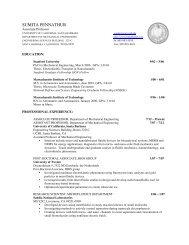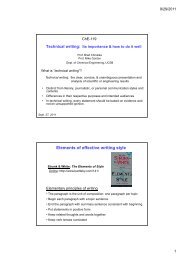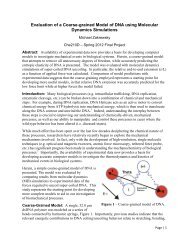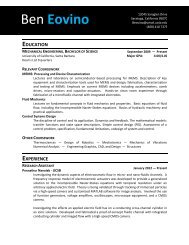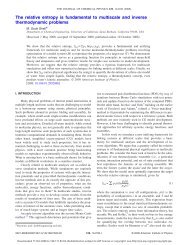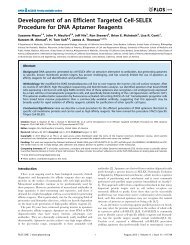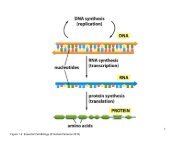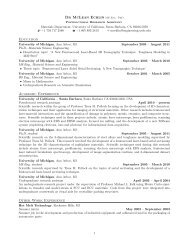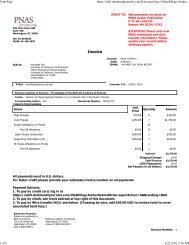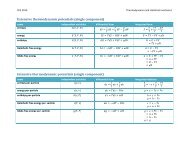Homework 4 - UCSB College of Engineering - University of ...
Homework 4 - UCSB College of Engineering - University of ...
Homework 4 - UCSB College of Engineering - University of ...
Create successful ePaper yourself
Turn your PDF publications into a flip-book with our unique Google optimized e-Paper software.
Problem 4<br />
The Nernst equation describes the relationship between equilibrium concentrations <strong>of</strong> ionic<br />
species partitioned across a membrane with potential drop Δ. That is, the concentrations <strong>of</strong><br />
species if they could freely move between the interior and the exterior <strong>of</strong> the membrane.<br />
Δ <br />
ln <br />
<br />
<br />
60 log <br />
<br />
<br />
60 log <br />
<br />
<br />
at 300 for +1 charged ions<br />
at 300 for -1 charged ions<br />
Consider a cell to be filled with four ionic species: Na+, K+, Cl- and negatively charged<br />
macromolecules like DNA and proteins. We will assume that the macromolecules are the only<br />
species that cannot cross the plasma membrane, while the small ions can by way <strong>of</strong><br />
transmembrane channels. The total concentration <strong>of</strong> these macromolecules, in units <strong>of</strong><br />
electron charge, is i,macro 125 . Outside <strong>of</strong> the cell, in the extracellular space, no<br />
macromolecules are present and the concentrations <strong>of</strong> the three small ions are approximately<br />
, 145 , 5 , 150 <br />
Note that there is a net charge <strong>of</strong> zero in the extracellular space (145 5 150 0). We will<br />
ignore any other ions.<br />
a) The net charge in the intracellular space must also be zero. If the intracellular concentrations<br />
also all obey the equilibrium Nernst relation for the same membrane potential, what will the<br />
potential Δ be Hint: write an equation demanding the net intracellular charge be zero, and<br />
then use the Nernst equation in it.<br />
b) If the macromolecule concentration were zero, what would the membrane potential be<br />
What would the concentration differences across the cell membrane look like at equilibrium<br />
c) In neurons, voltage-gated Na+ channels allow the rapid influx <strong>of</strong> sodium ions in response to<br />
the action potential, which rapidly changes the actual membrane potential from -60 mV to<br />
about 40 mV. If the exterior concentrations <strong>of</strong> the three ion species above remain the same,<br />
what would be the equilibrium intracellular concentration <strong>of</strong> K+ at this potential according to<br />
the Nernst relation Compare this concentration <strong>of</strong> K+ to the average actual concentration <strong>of</strong><br />
140 mM. Would there therefore be a driving force for the influx or efflux <strong>of</strong> K+ from the cell, at<br />
this membrane potential




